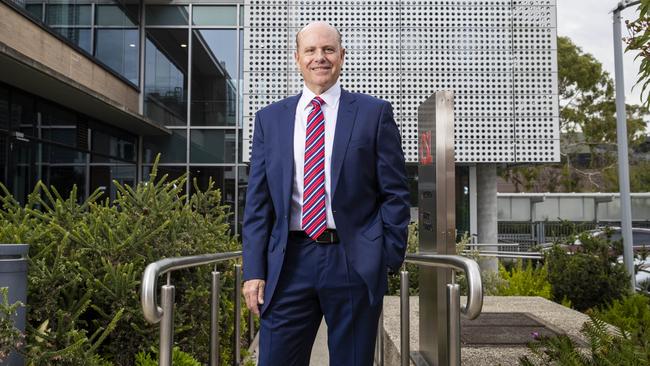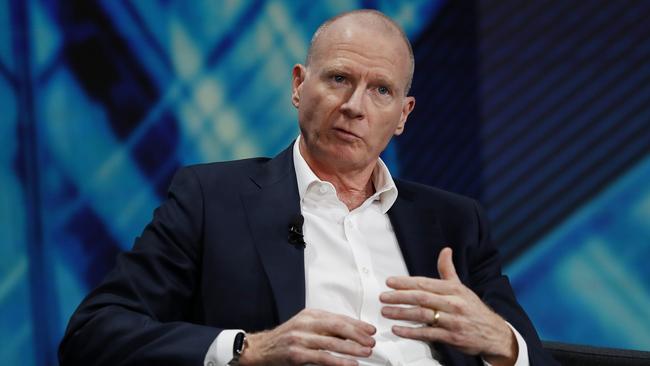Outgoing CSL boss Paul Perreault shares the secrets on how to build a $150bn biotech company
As Paul Perreault prepares to leave his role as chief executive of CSL, he shares his recipe for success after more than a decade at the helm of Australia’s biggest health company.

Australian biotechnology companies aiming to commercialise their painstaking research need to think more globally rather than waiting for a cashed-up pharmaceutical major to take them out.
That’s the message from CSL’s outgoing chief executive Paul Perreault, who has shared his secrets on how to build a successful biotech company and stem the tide of Australian research being commercialised overseas.
And he said generous government policies alone — such as research and development tax incentives — would not turbocharge manufacturing in Australia’s biotechnology sector.
“You have to look beyond what’s currently available and you have to think outside the box to innovate,” Mr Perreault said, offering some key parting advice before he finishes as CSL’s chief executive early next month following a decade at helm.
“It takes consistent policies. But government isn’t the only one that drives it. Innovation is driven from the private sector as well.”
Crucially, Mr Perreault — who oversaw a 400 per cent gain in CSL’s shares during his tenure — said companies forfeit the right to complain if they sell their research to a bigger rival, which then takes it overseas to develop further and manufacture.
“You can’t let some of the other big companies come in and just buy your tech, your knowledge, and then expect that you’re going to get credit for the development and success of the product.
“That’s why we see things leaving Australia because people are spending a lot of time and money and then all of a sudden they get bought out and they’re onto the next thing. And then it goes offshore and gets developed.”
It has been a well-trodden path for a lot of Australian companies. Take for example ResApp, which developed an app that could detect Covid-19 from someone coughing into a smart phone. Pfizer took over the company for $179m last year, with the target’s board backing the deal.
Further, NSW Supreme Court documents revealed ResApp’s executive director threatened legal action against a shareholder who was initially opposed to the takeover.
Meanwhile Martyn Myer — grandson of Sidney Myer and chair of the Peter Doherty Institute for Infection and Immunity and ASX-listed neuroscience company CogState — says the number of Australian biotechs pales in comparison to smaller countries such as Switzerland and Sweden.
But Cochlear chief executive Dig Howitt says while Australia is ranked highly in regard to research, it is less competitive in commercialisation.
“It’s not easy to commercialise research. There is an intent of companies to succeed globally — that varies by company,” Mr Howitt said.
“If you look around Australia, there’s some very successful companies that have formed over the last 10 or 20 years and are going global. People will have different motivations, always, and that’s okay.”

While companies have a fiduciary responsibility to maximise value for shareholders — which may mean a takeover is the best option — Mr Perreault is more of a long-term thinker.
He said CSL — which began as the Commonwealth Serum Laboratories in 1916 before being floated on the ASX in 1994 — would not have become a $150bn company if it didn’t have global aspirations.
“You do need scale to develop products and especially, you know, products for the masses as opposed to just rare diseases. And so you need to understand what that ecosystem looks like and how you protect that to really go outside of Australia to grow.
“That’s what CSL did. I mean, if we had not left Australia, we’d be another small also-ran company in Australia.
“But the reason why (CSL became big) was because we globalised: we went outside of Australia. We use that research base — that hub and spoke model, where the hub is here in Melbourne and its biomedical precinct — to actually globalise the development of these products. That’s how we did it. That’s what companies need to learn.”
To this end, CSL has created Australia’s first “incubator” for biotech start-ups that will be housed in its new global headquarters being built in Elizabeth St, Melbourne, as part of the city’s new biomedical precinct.
CSL will run the incubator in partnership with the Walter and Eliza Hall Institute, and the University of Melbourne, after it secured funding from the Victorian government’s $2bn Breakthrough Victoria Fund.
“It’s our job to foster that innovation … in the biomedical precinct, the start-up biotechs, and teach them about development because we are developers as well. We are innovators and developers.
“They will have interactions with our people in the same building. We have a community space where they can meet and talk and still protect their stuff and our stuff, but we have some common areas where they can meet and talk and share and learn. And that’s what it’s about. That’s what we’re trying to foster here. That’s what Australia needs more of within our space.”

CSL previously told a 2014 Senate inquiry on innovation that: “Australia is a relatively unattractive location for entrepreneurial manufacturing or as a base from which to commercialise locally developed intellectual property into global markets.
“This is principally a function of Australia’s uncompetitive corporate tax system, but is exacerbated by declining access to some important specialised skills, high overall labour costs, location, terms of trade, resulting in a sustained strong currency, and the complexities of dealing with Australia’s system of government and regulation.”
Despite this criticism, the company has continued to invest in Australia — opening a $1bn plasma fractionation factory in Melbourne in December to deliver a nine-fold increase in production for its lifesaving products to export to more than 100 countries.
It is also building an $800m cell-based influenza vaccine plant in Tullamarine, replicating a similar facility it has on the US east coast.
“We’re here to support Australia. We’re not leaving Australia, because we don’t have this type of presence in the southern hemisphere,” said Mr Perreault when he opened the plasma factory.





To join the conversation, please log in. Don't have an account? Register
Join the conversation, you are commenting as Logout